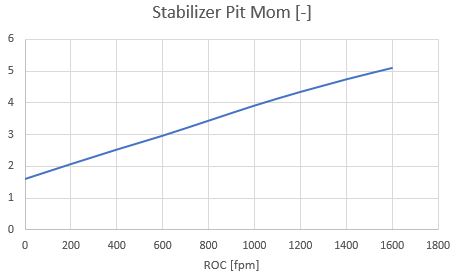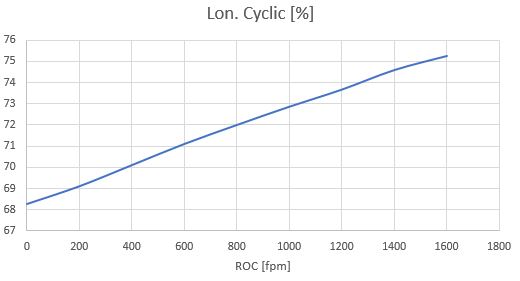SpinningWing > Helicopters > Helicopter Flight, Control and Stability > Helicopter Climbs
Helicopter ClimbsIn this article, we examine how various values (flapping, pitch, torque, …) change as the climb rate of a helicopter increases from 0 to 1600 feet per minute (fpm). We consider a set of unaccelerated, trimmed flight conditions at each of several climb rates. We then compare how quantities like pitch, flapping, torque, … change as a function of the climb rate. Each point is at 100kts forward airspeed with 0 degrees of roll, and all use the same aircraft weight and CG location. AOA, collective, torque and main rotor thrustAt larger climb rates, the angle of attack (AOA) of a helicopter decreases. In forward flight, climb rates are typically very small compared to the forward speed, so the AOA doesn’t decrease as much as you might expect. All cases here are at 100kts forward airspeed, and the AOA only decreases from about 0 to -8 deg (as the climb rate increases from 0 to 1600fpm, as shown in the plot below). The downflow of air associated with negative AOA pushes the fuselage and stabilizer down (about 1% of GW each) requiring larger main rotor feathering—both to counter the download to other components, and to compensate for the increased airflow down through the rotor. Hence, collective increases substantially with climb rate as shown in the plot. These phenomena also increase the amount of main rotor torque required.
Flapping, pitch and cyclicAs the climb rate increases, the download on the stabilizer causes a significant, nose up pitch moment as shown in the plots below. This is partially countered by a nose down fuselage pitch moment, but forward main rotor flapping is necessary to fully balance the pitch moments on the aircraft. Forward longitudinal cyclic is therefore required, not just to attain this forward flapping, but also to counter aft flapping that would naturally occur with higher collective. In order to balance the longitudinal force on the helicopter, pitch angle increases with climb rate (preventing the increased rotor thrust from accelerating the helicopter forward).
Misc. other valuesSince the torque supplied to the main rotor increases so much, tail rotor thrust must increase with climb rate. This is achieved by decreasing pedal (more left pedal), as shown in the plots below. This tail rotor thrust pushes the helicopter to the right, increasing sideslip (also shown in the plots below).
|













